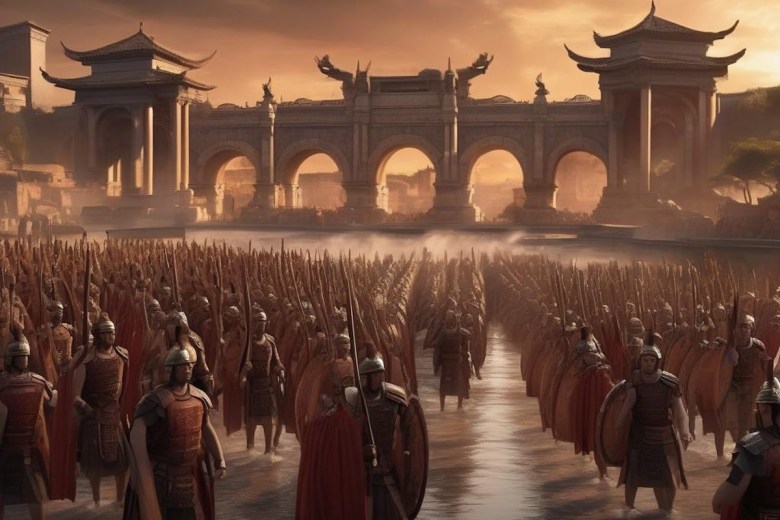Science
Exploring Ancient Rome and China: Divergent Paths to Power

During the First World History Frontiers Forum on September 12, 2025, in Beijing, Feng Youlan delivered a thought-provoking speech titled “First notes on geo-philosophy.” This presentation, published by the Appia Institute, explored the contrasting historical developments of ancient Rome and China, emphasizing how their geographical environments shaped their respective political and social structures.
Geographical Influences on Civilization
The ancient Roman Empire thrived around the Mediterranean Sea, building upon the knowledge and skills of the Greeks and Phoenicians. These earlier civilizations had established themselves as accomplished navigators and traders, and Rome’s ascent required it to assert control over the Italian peninsula. Their early ships featured two lines of rowers, each contributing equally to the vessel’s movement, while the captain, defined by his heavy oar, guided them. This emphasis on equality and cooperation was also evident in the structure of the Greek phalanx, which served as a model for the Roman legion. Cohesion was paramount; a single misstep could lead to disaster, whether in naval battles or on land.
The Mediterranean’s unpredictable conditions necessitated flexibility and adaptability, rather than rigid adherence to a singular strategy. As Feng noted, the political framework of the time, exemplified by Sparta’s dual kingship and Rome’s system of two consuls, was designed to correct errors made by previous leaders. This governance model proved effective, allowing the Greek League to triumph over the Persian Empire and enabling Alexander of Macedon to forge an empire that spanned vast territories.
In stark contrast, ancient China’s geographical landscape was predominantly enclosed. To the north lay expansive steppes, to the west harsh deserts and mountains, and to the south dense jungles. The eastern boundaries were marked by an archipelago and a peninsula, with an immense ocean beyond. This challenging terrain fostered a need for organized groups capable of executing long-term plans, such as managing river systems and clearing land for agriculture.
Distinct Political Structures and Philosophies
The hierarchical social organization in China was essential for overcoming the challenges posed by its environment. Authority legitimized this organization, leading to successful agricultural and military expansions. The effectiveness of governance was tied to the ruler’s capabilities, emphasizing loyalty over rights. Decisions made by the emperor were critical; their failures could lead to the collapse of dynasties.
During the fourth and fifth centuries BCE, a significant philosophical discourse emerged in China, as documented by the philosopher Mozi. Mozi’s works, particularly his chapters titled Fei (Against), challenged prevailing ideologies, including Confucianism and the advocacy of offensive warfare by Sunzi. Mozi proposed a balanced power structure to prevent larger states from overpowering smaller ones, advocating for a defensive posture rather than aggression.
Unlike the Greek phalanx or Roman legion, which operated as armies of equals, Chinese military organization remained hierarchical. While Greek and Roman warriors shared a camaraderie strengthened by mutual respect and affection, Chinese soldiers did not develop the same bonds. The absence of a concept of dying heroically for one’s comrades marked a significant cultural divergence.
In ancient Rome, the economy was built on agriculture, conquest, and the acquisition of wealth through raids. Conversely, China’s wealth primarily stemmed from agriculture and industry. War was often seen as a drain on resources unless it led to territorial expansion that enhanced agricultural productivity.
Moreover, while the unification of the Mediterranean occurred only once under Roman rule, the theme of unification recurred throughout Chinese history, particularly during the Sui and Tang dynasties. This unification encompassed not just geography but also a sense of historical continuity and succession among dynasties.
The contrasting paths of these two great civilizations highlight their unique strengths and weaknesses. As noted by Feng Youlan, there are no definitive right or wrong approaches; instead, both Rome and China offer valuable lessons shaped by their distinct geographical and historical contexts. The modern challenge lies in reconciling these divergent histories to foster peaceful coexistence and cooperation.
Philosophy serves as a powerful tool for addressing historical complexities and guiding contemporary discourse, enabling a clearer understanding of the past and its implications for the future.
-

 Lifestyle4 months ago
Lifestyle4 months agoHumanism Camp Engages 250 Youths in Summer Fest 2025
-

 Business5 months ago
Business5 months agoKenvue Dismisses CEO Thibaut Mongon as Strategic Review Advances
-

 Sports4 months ago
Sports4 months agoDe Minaur Triumphs at Washington Open After Thrilling Comeback
-

 Sports5 months ago
Sports5 months agoTupou and Daugunu Join First Nations Squad for Lions Clash
-

 Top Stories5 months ago
Top Stories5 months agoColombian Senator Miguel Uribe Shows Signs of Recovery After Attack
-

 World5 months ago
World5 months agoASEAN Gears Up for Historic Joint Meeting of Foreign and Economic Ministers
-

 Health4 months ago
Health4 months agoNew Study Challenges Assumptions About Aging and Inflammation
-

 Business5 months ago
Business5 months agoOil Prices Surge Following New EU Sanctions on Russia
-

 Entertainment4 months ago
Entertainment4 months agoDetaşe-Sabah Violin Ensemble Captivates at Gabala Music Festival
-

 Entertainment4 months ago
Entertainment4 months agoBaku Metro Extends Hours for Justin Timberlake Concert
-

 Top Stories5 months ago
Top Stories5 months agoRethinking Singapore’s F&B Regulations Amid Business Closures
-

 Business5 months ago
Business5 months agoU.S. House Approves Stablecoin Bill, Sends to Trump for Signature









